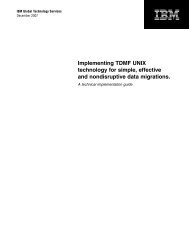Making Connections: Using SOA to enable collaboration in travel - IBM
Making Connections: Using SOA to enable collaboration in travel - IBM
Making Connections: Using SOA to enable collaboration in travel - IBM
You also want an ePaper? Increase the reach of your titles
YUMPU automatically turns print PDFs into web optimized ePapers that Google loves.
<strong>Mak<strong>in</strong>g</strong> connections<br />
<strong>Us<strong>in</strong>g</strong> <strong>SOA</strong> <strong>to</strong> <strong>enable</strong> <strong>collaboration</strong> <strong>in</strong> <strong>travel</strong> and transportation<br />
<strong>SOA</strong> can help facilitate<br />
cross-border <strong>travel</strong><br />
and lower the cost of<br />
cross-border trades.<br />
In essence, <strong>SOA</strong> strips the verticality and<br />
rigidity out of different or proprietary IT systems<br />
and then bends them <strong>to</strong> the needs of the user.<br />
An <strong>SOA</strong> approach <strong>to</strong> systems <strong>in</strong>tegration<br />
requires a collaborative design effort <strong>in</strong>volv<strong>in</strong>g<br />
both bus<strong>in</strong>ess and technology. Statistics<br />
show, however, that only 68 percent of IT<br />
professionals have a basic understand<strong>in</strong>g of<br />
<strong>SOA</strong>. 4 Their stakeholders are even less likely<br />
<strong>to</strong> understand how <strong>SOA</strong> can work for them.<br />
Our objective with this report is <strong>to</strong> provide<br />
an educational <strong>to</strong>ol for both bus<strong>in</strong>ess and<br />
IT professionals and lower the gap between<br />
those who can benefit from <strong>SOA</strong> and those<br />
who understand its implementation.<br />
To facilitate understand<strong>in</strong>g of how <strong>SOA</strong> can be<br />
used <strong>to</strong> address issues <strong>in</strong> <strong>travel</strong> and transportation,<br />
we will exam<strong>in</strong>e how <strong>SOA</strong> can be used<br />
<strong>in</strong> two specific, strategic scenarios <strong>in</strong> the <strong>travel</strong><br />
and transportation <strong>in</strong>dustries:<br />
• Facilitat<strong>in</strong>g cross-border <strong>travel</strong> with collaborative<br />
advance passenger analysis (APA)<br />
systems<br />
• Lower<strong>in</strong>g the cost of cross-border trades by<br />
<strong>in</strong>tegrat<strong>in</strong>g cus<strong>to</strong>ms with various transportation<br />
and trade stakeholders.<br />
For each scenario, we will describe the bus<strong>in</strong>ess<br />
problem, how it can be addressed<br />
us<strong>in</strong>g <strong>SOA</strong> and the benefits derived from<br />
the solution. These solutions are not meant<br />
<strong>to</strong> be def<strong>in</strong>itive or complete. Rather, they are<br />
designed <strong>to</strong> demonstrate the application of<br />
<strong>SOA</strong> <strong>to</strong> <strong>in</strong>tegrate the systems that support the<br />
<strong>travel</strong> and transportation <strong>in</strong>dustries.<br />
3 <strong>Mak<strong>in</strong>g</strong> connections<br />
Facilitat<strong>in</strong>g cross-border <strong>travel</strong><br />
Travel travails<br />
With the projected <strong>in</strong>crease <strong>in</strong> <strong>in</strong>ternational<br />
<strong>travel</strong>, the problems faced by airl<strong>in</strong>es, other<br />
carriers and governments are expected <strong>to</strong><br />
rise exponentially. Rapid growth is creat<strong>in</strong>g<br />
obstacles <strong>in</strong> verify<strong>in</strong>g the identity of <strong>travel</strong>ers,<br />
screen<strong>in</strong>g for security, check<strong>in</strong>g the admissibility<br />
of goods, enforc<strong>in</strong>g national regulations<br />
and collect<strong>in</strong>g revenues.<br />
International air <strong>travel</strong> is a clear example of<br />
where security and border <strong>in</strong>tegrity conflicts<br />
with <strong>travel</strong>er convenience—and carrier cost<br />
of do<strong>in</strong>g bus<strong>in</strong>ess. More security checks<br />
mean that an ever-grow<strong>in</strong>g number of passengers<br />
are fac<strong>in</strong>g ever-longer delays. Delays <strong>in</strong><br />
security checks often result <strong>in</strong> flight delays,<br />
which compound <strong>to</strong> have detrimental impact<br />
on airl<strong>in</strong>e schedules throughout the world.<br />
Delayed schedules lead <strong>to</strong> <strong>in</strong>creased costs –<br />
without the ability <strong>to</strong> easily absorb these costs<br />
<strong>in</strong> the price of <strong>travel</strong>. Besides cop<strong>in</strong>g with<br />
the <strong>in</strong>creased costs, airl<strong>in</strong>es must deal with<br />
decl<strong>in</strong><strong>in</strong>g cus<strong>to</strong>mer satisfaction that impedes<br />
short-term sales.<br />
Aga<strong>in</strong>, multiple solutions present themselves,<br />
such as the build<strong>in</strong>g of more airports,<br />
<strong>in</strong>creas<strong>in</strong>g the number of security gates and<br />
hir<strong>in</strong>g more people. But these are often costly,<br />
environmentally unacceptable or may not fit <strong>in</strong><br />
the available physical space.<br />
Yet, many of these issues can likely be mitigated<br />
by the comb<strong>in</strong>ation of the right policies,<br />
the right technology and <strong>in</strong>creased <strong>collaboration</strong>.<br />
Governments are pursu<strong>in</strong>g solutions that

















